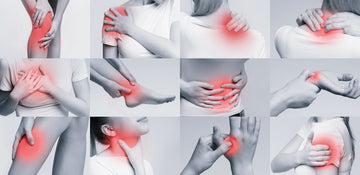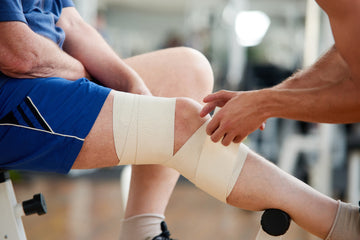Pain is a complex experience that can affect our daily lives in various ways. While localized pain in specific areas of the body is relatively common, some individuals may experience a puzzling phenomenon—pain that moves around the body. This type of pain that moves to different parts of the body can be frustrating and confusing, making it difficult to determine what the root cause is.
Find yourself asking the question, “why do I have pain that moves around my body?” Today, we’re taking a look at different acute and chronic conditions that cause pain that moves around the body. We’re also examining the link between pain and inflammation, lifestyle factors that may contribute to your pain, and tips to alleviate it. Learn more below and start to improve your overall quality of life.
The Cause: Why Do I Have Pain That Moves Around My Body?
If you’re experiencing this baffling health ailment, no doubt you’ve asked the question, “why do I have pain that moves around my body?” While each case is different, pain that moves around the body can have several common underlying causes.
Fibromyalgia
One possible explanation is fibromyalgia. Fibromyalgia is often characterized by widespread musculoskeletal pain, fatigue, and sleep interruptions. People living with fibromyalgia often experience a shifting pain, or pain that moves to different parts of the body. The exact cause of fibromyalgia is not yet fully understood, but it is believed to involve a combination of genetic, environmental, and psychological factors.
Treatment Idea: Learn about using massage therapy for fibromyalgia after this and see how it might help manage symptoms of pain that moves around the body.
Arthritis
Another common possible cause of pain that moves around the body is rheumatoid arthritis (RA). RA is an autoimmune disorder that primarily affects the joints and can cause pain, swelling, and stiffness. The pain experienced by individuals with RA can migrate from one joint to another, making it challenging to pinpoint the exact starting location of your discomfort.
Treatment Idea: Check out our guide to what helps arthritis pain and flare-ups to reduce your pain levels and get back on your feet!
Other Medical Conditions That May Result in Moving Pain
While fibromyalgia and arthritis are two of the most common underlying causes of pain that moves around the body, there can be other health ailments that exacerbate the problem, too. Each person may experience pain for different reasons, so it’s imperative that you consult your doctor for a proper diagnosis.
Some medical conditions or ailments that may worsen pain that moves around the body include:
- Nerve disorders: Nerve disorders can cause pain that travels along the affected nerves, leading to pain that moves around the body. Conditions such as neuropathy, which can result from various causes like diabetes, vitamin deficiencies, or nerve compression like sciatica, can cause shooting or burning pain that moves from one area to another.
- Chronic inflammatory conditions: Chronic inflammatory conditions like gout, an inflammatory arthritis caused by the buildup of uric acid crystals in joints, can lead to sudden and severe joint pain that can shift from one joint to another.
- Chronic diseases: Certain chronic or infectious diseases can cause pain that moves around the body. Lyme disease, for example, can lead to moving joint pain, muscle aches, and neurological symptoms.
- Degenerative diseases: Various degenerative diseases can contribute to pain that moves around the body, as well. For example, conditions like osteoarthritis can result in pain that shifts as different areas of the body become stressed or strained.
Connection Between Pain and Inflammation
When asking the question, “why do I have pain that moves around my body?” it’s helpful to understand the connection between pain and inflammation.
Inflammation is the body's natural response to injury, infection, or tissue damage. In acute injuries, such as common sports injuries like a sprained ankle or a cut, inflammation serves a protective role in the healing process.
When inflammation becomes chronic, however, it can affect multiple areas and result in pain that moves around the body. Inflammatory conditions, including autoimmune disorders like rheumatoid arthritis or lupus, can trigger widespread inflammation throughout the body. This inflammation may affect joints, muscles, and other tissues, causing moving pain or discomfort. Additionally, inflammation can amplify pain signals making the pain more likely to be felt in multiple areas and manifest as pain that moves to different parts of the body.
Managing inflammation by consulting with your doctor, making simple lifestyle adjustments, and taking measures to reduce or eliminate inflammation such as using a massage chair for recovery can all play a vital role in lessening moving pain.
Is My Lifestyle Causing Pain That Moves Around the Body?
One of the first things your doctor may discuss if you ask, “why do I have pain that moves around my body?” is what your lifestyle is like. Are you active? Sedentary? Do you play sports or exercise? What about self care activities? Each of these may play a role in managing pain that moves around the body.
Some common lifestyle factors that may be contributing to pain that moves to different parts of the body include:
- Stress: Chronic stress can have a significant impact on pain perception. When we experience stress, our bodies release stress hormones like cortisol, which can heighten pain sensitivity. Moreover, the physical signs of stress often include muscle tension and pain that moves around the body.
- Sleep habits: Poor sleep quality or bad sleeping habits can worsen pain symptoms and contribute to pain that moves around the body. Sleep is vital for your body’s recovery. When we don't get enough sleep or experience disruptions in sleep patterns, our pain levels can become heightened.
- Sedentary lifestyle: Lack of physical activity and a sedentary lifestyle can contribute to pain that moves around the body. Regular exercise has been shown to have numerous benefits, including pain reduction. Exercise helps release endorphins, which are natural pain-relieving chemicals produced by the body. It also improves circulation that fights inflammation, can strengthen muscles, and promotes your overall well-being.
- Posture: Poor posture and other bad sitting habits can place unnecessary strain on the neck and lower back, leading to pain that moves around the body from top to bottom. Spending long hours in positions that put excessive pressure on certain areas, such as sitting at a desk without an ergonomic chair or carrying heavy objects improperly, can contribute to your discomfort.
- Diet: Although the relationship between diet and pain is complex, certain dietary factors can contribute to inflammation and exacerbate symptoms of pain that moves to different parts of the body. Consuming a diet high in processed foods, refined sugars, and unhealthy fats may result in added inflammation within the body.
Relieving Pain That Moves to Different Parts of the Body
Asking your doctor the question, “why do I have pain that moves around my body?” begins the conversation on managing symptoms and treating this pain as best you can. Pain management and treatment can come in various forms ranging from rest and recovery to being active or changing up other lifestyle factors.
A few tips for alleviating pain that moves to different parts of the body are:
- Stress management: Techniques such as deep breathing exercises, mindfulness meditation, or engaging in activities that promote relaxation and reduce stress levels.
- Exercise and physical activity: Regular physical activity can help alleviate pain and improve your overall well-being. Engage in low-impact exercises or activities that are suitable for any physical limitations due to the pain you’re experiencing.
- Practice better sleep habits: Start a consistent sleep routine, create a conducive sleep environment, and practice good sleep positioning to promote restful sleep and help with pain relief.
- Massage therapy: Massage therapy can be beneficial in relieving pain and promoting relaxation. Instead of trying to fit traditional massage appointments into your schedule, consider a luxury massage chair to experience the benefits of massage therapy at home. Today’s massage chairs offer many different types of massage as well as bonus features like heat therapy and zero gravity reclining — all at the touch of a button. They’ll enhance your recovery and may alleviate pain that moves around the body by treating your whole body at once.
Remember, before starting any new health routine, consult with your doctor to develop a comprehensive treatment plan that addresses the underlying causes of your pain.
So, why do I have pain that moves around my body? There could be many underlying causes from health conditions to lifestyle factors. After getting professional medical guidance, consider methods like exercising regularly, improving sleep habits, managing health conditions effectively, or choosing a massage chair for full-body recovery to have you feeling your best once again.





